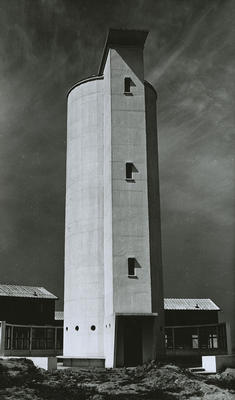
Milton water tower, photographed in 1949. In the background are the steel-framed BISF houses that were built for Glasgow Corporation by the British Iron and Steel Federation. A paved terrace with seating surrounds the base of the tower. The open space was subsequently developed as a public garden.
The water tower stood on the highest ground in the area. Because of its prominence, the architects attempted to design a structure which would serve its practical function as a water tower but also as a point of interest on the landscape.
The tower was 19 feet in diameter and 55 feet high and carried 24,300 gallons of water in a tank over 21 feet in depth. The walls were made of reinforced concrete, between 8 and 12 inches thick. A narrow stair gave access to the roof and to the tank.
The rapid increase in the number of housing schemes in the post-war years provided a challenge to the Corporation's Water Department to ensure that they were adequately supplied with water. Other areas where large water towers became a prominent landmark included Pollok, Priesthill, Cranhill, Garthamlock, Drumchapel and Springburn. Most were eventually replaced by reservoirs.
Reference: D-AP9/7/10/8
Reproduced with the permission of Glasgow City Council, Libraries, Information and Learning
Keywords:
BISF, British Iron and Steel Federation, council houses, housing estates, housing schemes, landmarks, reinforced concrete, reservoirs, Water Department, water supply, water towers
You have 0 images in your photo album.